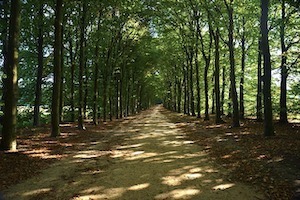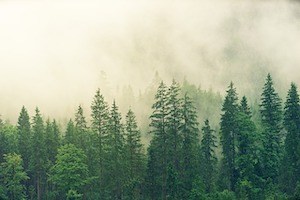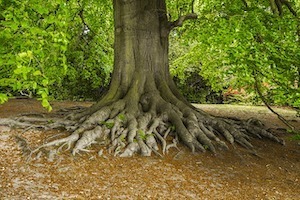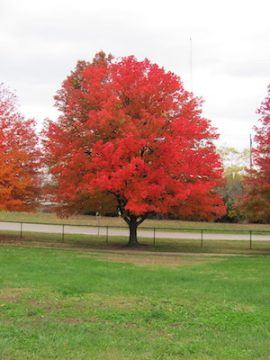by Mary Hrovat
 The roof of Notre-Dame de Paris, lost in the fire of April 15, 2019, was nicknamed The Forest because it used to be one. It contained the wood of around 1300 oaks, which would have covered more than 52 acres. They were felled from 1160 to 1170, when they were likely several hundred years old. It has been estimated that there is no similar stand of oak trees anywhere on the planet today.
The roof of Notre-Dame de Paris, lost in the fire of April 15, 2019, was nicknamed The Forest because it used to be one. It contained the wood of around 1300 oaks, which would have covered more than 52 acres. They were felled from 1160 to 1170, when they were likely several hundred years old. It has been estimated that there is no similar stand of oak trees anywhere on the planet today.
Even in the twelfth century, sourcing the wood for cathedral construction was not always easy. When the Basilica of Saint-Denis was under construction in the mid-twelfth century, it was assumed that the nearby forests could not supply the wood needed for the project because they were depleted. Abbot Suger reportedly found a local stand of timber suitable for the job and attributed his discovery to faith and divine intervention. Causes of medieval deforestation include clearing of land for agriculture and the expansion of urban areas.
###
Trees have been and continue to be tremendously useful to humans. Forests have long supplied fruit, nuts, livestock feed, shade, and habitat for game animals. Wood is used for heating and cooking and as a building material for everything from houses to defensive structures to ships for war and trade. For centuries, almost everything used to build a ship came from the forest, including the pitch used to caulk the seams.
More recently, wood was essential to the development and industrialization of the United States. Early railways needed vast amounts of wood for fuel, railroad ties, signal poles, train cars, and sometimes even the rails themselves (for the first railroads in the U.S., and in the South during the Civil War). Wood was used for fencing. Trees supplied the tannins required for the leather industry. Late in the 19th century, wood pulp replaced rags in paper production. According to an 1883 report from the U.S. Commissioner of Agriculture, “There is scarcely a comfort or convenience of life with which the forests are not intimately connected.”
It’s tempting to say that the profound usefulness of trees is the force driving deforestation. But that’s not the whole story. Given how essential trees are, wouldn’t a thoughtful species respect them more?
###
Deforestation in the Middle Ages was largely the result of increased urbanization and advances in technology (for example, mining required wood to make charcoal for ore smelting). Locally, war could take a heavy toll. Much of the forest around Paris in Abbot Suger’s day had been used for military fortifications. Forests also dwindled, for similar reasons, under the ancient Greeks, Romans, and even Egyptians, despite the fact that Egypt was much less densely forested and thus trees were more highly valued. Trees were not only cut for human use; they were sometimes burned as an act of war.
Over centuries, the Mediterranean environment of antiquity was diminished by deforestation. The results included erosion and then siltation, after the eroded soil was carried to low-lying areas, creating marshlands where mosquitos thrived. In addition, deforestation resulted in flooding, disruption of water supplies, and changes in microclimate. Sheep and goats, with their sharp and damaging hooves, were sometimes grazed on deforested land, making it much less likely that the forests could ever recover. People of the time were aware of land management practices that used trees without depleting them, but economic or political pressures sometimes prevented their application, especially in Imperial Rome.
###
Similar environmental problems accompanied medieval deforestation. By the 15th century, wood for cooking and heating was becoming scarce in parts of Europe. England in particular was desperate for trees. One reason was England’s need to equip its navy. It took about 2000 mature oak trees to build a large naval warship; at least 50 acres of forest would have to be cleared to make such a vessel.
Richard Hakluyt, who advocated strongly for English colonization of North America, thought that one of his strongest selling points was the fact that the New World was infinitely rich with useful trees. His estimate was based on the incredible abundance of New England’s untouched forest, but as it turned out, shipping and labor were so expensive that the timber trade didn’t actually recoup the cost of colonization for investors back in England; instead, the colonists developed relationships with other trading partners. It also turns out that there is no such thing as a limitless resource.
 The seemingly inexhaustible timber resources of the U.S. have been greatly diminished by generations of logging. The rich forests of New England were cleared for building or farming, although timber was also exported or sent to England in colonial times. We hear a lot about the Boston Tea Party, but another source of discontent among the colonists was the Royal Navy’s claim to the trees it needed for its ships. The colonists found many uses for the tall, straight eastern white pine, which at the time was abundant and had grown to spectacular dimensions, and they also exported these trees to shipbuilding ports for use as masts. But the Navy claimed first dibs on them, and the King’s Broad Arrow, which surveyors marked on the trees it claimed, was a target of colonist indignation.
The seemingly inexhaustible timber resources of the U.S. have been greatly diminished by generations of logging. The rich forests of New England were cleared for building or farming, although timber was also exported or sent to England in colonial times. We hear a lot about the Boston Tea Party, but another source of discontent among the colonists was the Royal Navy’s claim to the trees it needed for its ships. The colonists found many uses for the tall, straight eastern white pine, which at the time was abundant and had grown to spectacular dimensions, and they also exported these trees to shipbuilding ports for use as masts. But the Navy claimed first dibs on them, and the King’s Broad Arrow, which surveyors marked on the trees it claimed, was a target of colonist indignation.
Later, the forests of the Great Lake States were taken for lumber. The cleared land turned out to have relatively poor soil for farming, but because the forests were cleared largely for the use of the wood, and not for farming, the subsequent fate of the land was not necessarily a concern. After the Civil War, the pine forests of the South were logged (often by northerners), and in the twentieth century, logging began in the Pacific Northwest.
Not only were trees in high demand in the earlier decades of U.S. history; they were so plentiful that it didn’t seem necessary to be frugal in their use. There seemed to be little penalty, at the time, for using trees wastefully rather than expending either capital or labor. Log cabins, for example, were not an efficient design, but they were quicker and easier to build than traditional houses. Another example is that it was much simpler to cut wood into large pieces for wide fireplaces, and the time saved was more important than the fact that much of the heat escaped up the chimney. Benjamin Franklin introduced his much more efficient Franklin stove to halt the waste, but it was a hard sell for people who were surrounded by forests. Why chop the wood to the smaller size required for the small stove when there apparently would always be plenty of wood?
###
Efficiency, as desirable as it is, has its limitations. For one thing, if something is being used efficiently, people will sometimes use more of it. Building more fuel-efficient cars, for example, has been found to have a rebound effect in which some of the reduced energy consumption is lost because people drive more. Furthermore, in the framework of efficiency, trees are resources.
 Trees have long been venerated for a perceived association with the gods, and forests have been considered sacred spaces. According to Pliny the Elder, “Trees were the first temples of the gods, and even now … we worship forests and the very silences they contain.” The sacred groves of the ancient Greeks and Romans were preserved in more or less their natural state; they were not exploited like other forested lands, although they were not off-limits to humans.
Trees have long been venerated for a perceived association with the gods, and forests have been considered sacred spaces. According to Pliny the Elder, “Trees were the first temples of the gods, and even now … we worship forests and the very silences they contain.” The sacred groves of the ancient Greeks and Romans were preserved in more or less their natural state; they were not exploited like other forested lands, although they were not off-limits to humans.
The pagans of Northern Europe also venerated forests and particular trees. Early Christianity fought against these traditions; sacred groves were reportedly destroyed or desecrated and individual trees cut down by missionaries to the pagans. But in practice I think it might be more accurate to say that Christianity co-opted the sacred aspects of trees for its own purposes.
Saint Boniface, an eighth-century Anglo-Saxon missionary to what is now Germany, supposedly oversaw the felling of Donar’s Oak, a tree that was sacred to Germanic pagans, and had a Christian church built with the wood. Chartres was built on the site of a sacred grove, and there’s been speculation that decorations on the south facade refer to the earlier trees on the site. Trees also found their way back into sacred spaces in more subtle ways. In Gothic cathedrals, the rows of pillars and the stone tracery of the vaults resembled a stylized version of the trunks and branches of trees in a forest.
Centuries after the medieval cathedrals were built, writers referred back to them and to the temples of Greece and Rome to describe the New World’s vast forests. William Cullen Bryant began his poem A Forest Hymn with the line “The groves were God’s first temples.” As the western U.S. was opened to exploration, the cathedral became an explicit metaphor for the great western forests. John Muir picked up on Bryant’s poem, using “God’s First Temples: How Shall We Preserve Our Forests” as the title for an 1876 editorial in the Sacramento Daily Record-Union. Later, in response to a proposal to dam California’s Hetch Hetchy Valley, Muir wrote, “Dam Hetch Hetchy! As well dam for water-tanks the people’s cathedrals and churches, for no holier temple has ever been consecrated by the heart of man.”
###
Hetch Hetchy was dammed, in the end (even though it was part of Yosemite National Park), but Yosemite Valley was preserved. The protected groves of the Greeks and Romans arguably represented a relic of earlier views of all Earth as one vast organism of which humans are only a part. However, the very holiness of a sacred grove can desacralize the areas outside the reach of the god’s protective hand, providing tacit permission to use them as we like. I think that national parks were established in the United States to push back against an assumption that the entire Earth is a resource to be commodified, and to carve out parts of it that should be spared. Even national and state parks are largely seen as valuable because they offer opportunities for recreation and renewal, not for any intrinsic value in nature itself.
Our modern view of nature as a resource for human use is impoverished, but finding another view is difficult. A totally secular worldview still has room for the concept of respect and reverence for something larger, older, and more powerful than ourselves, something that not only sustains us but nurtures us. I’m not sure we have the language to express this concept. The word sacred has such a long history of being used to refer to the gods or to a specific deity that it doesn’t seem suitable here. However, there’s a connotation of responsibility or even relationship that seems implicit in the word sacred and that I think is largely lost from more secular descriptions of nature. Wendell Berry hints at this responsibility in his poem How to Be a Poet, where he wrote that “There are no unsacred places; there are only sacred places and desecrated places.”
 As hard as it is for modern secular societies to translate the concept of the sacred into a non-religious attitude of respect and humility, it’s even harder to develop a concept of the intrinsic value of nature regardless of what it offers us in terms of survival, money-making, recreation, or even beauty. It’s been so difficult to protect wild land sufficiently to provide recreational encounters with pockets of preserved wilderness that we don’t always see how limited a goal this is. What would it be like to see ourselves as surrounded by and embedded in nature, and feel ourselves obligated to treat all of it as valuable?
As hard as it is for modern secular societies to translate the concept of the sacred into a non-religious attitude of respect and humility, it’s even harder to develop a concept of the intrinsic value of nature regardless of what it offers us in terms of survival, money-making, recreation, or even beauty. It’s been so difficult to protect wild land sufficiently to provide recreational encounters with pockets of preserved wilderness that we don’t always see how limited a goal this is. What would it be like to see ourselves as surrounded by and embedded in nature, and feel ourselves obligated to treat all of it as valuable?
This kind of view would require us to treat trees very differently: by not wasting their wood on frivolities, for example. (I think of trees every time paper junk mail lands in my mailbox, despite my efforts to eliminate it. What ghastly system have we created that makes it seem sensible to expend energy—emitting carbon dioxide in the process—and harvest trees to send out advertisements that often go straight to the recycle bin?) We would need to build our cities more densely so as to limit the land required to house us, and we would need to have many more trees in cities. We would need to stop clearing forests for livestock (that is, to eat less meat). I would say we need to not replace the roof of Notre Dame (a symbol of a past worldview) with another wooden roof. Ultimately, we would need to greatly decrease the human population.
###
Sustainability might be a valuable concept to cultivate, insofar as it recognizes that we can’t go on using up the planet the way we have been. However, sustainability, like efficiency, can wind up supporting the status quo by suggesting that greener or more earth-friendly ways of supporting our current patterns of consumption are available. It’s about preserving natural resources in order to preserve our own future ability to consume. I’m not sure it goes far enough toward reframing our place in nature and making drastic changes in, for example, our systems of housing and transportation (to name two issues that are currently under discussion in my community and many others).
For now, though, sustainability and efficiency seem to be the best ideas we have. There are signs that we are at least beginning to appreciate the economic value of trees. My city’s tree inventory reports the economic benefits of trees as well as their types and locations. The climate change strikers here demanded that the city increase its tree cover, including its fruit tree inventory, because trees are a good carbon sink. I hope the city meets this challenge. Enlightened self-interest is better than sustained exploitation. Still, it’s only the first step.
###
Image of trees lining a path is by Patty Jansen from Pixabay.
Image of a forest in fog is by Johannes Plenio from Pixabay.
Image of the base of a tree is by Roman Grac from Pixabay.
Image of a red maple in the fall is my own.
You can see more of my writing at maryhrovat.com.
